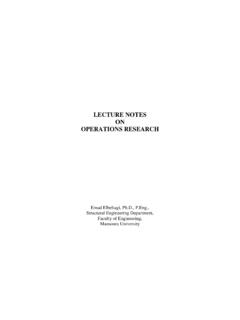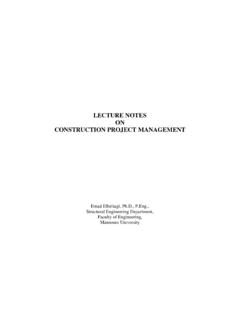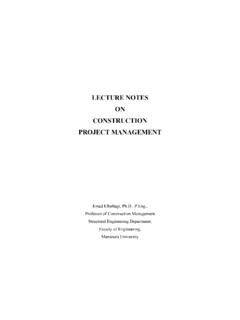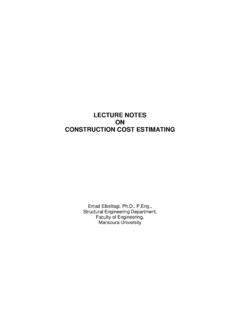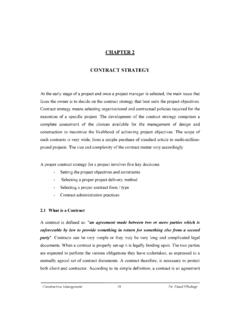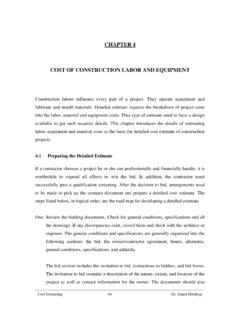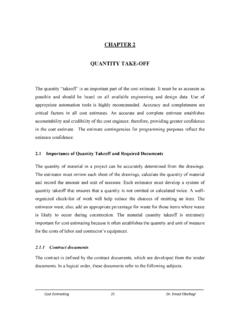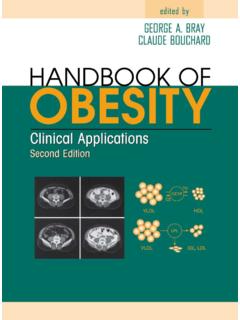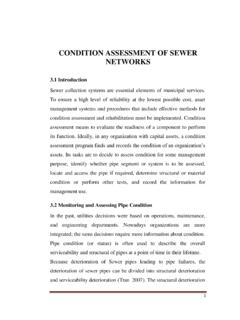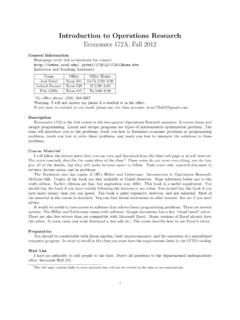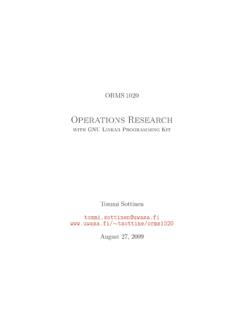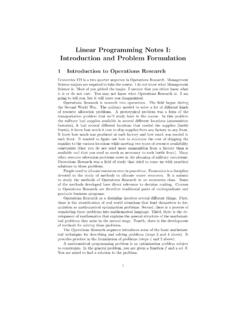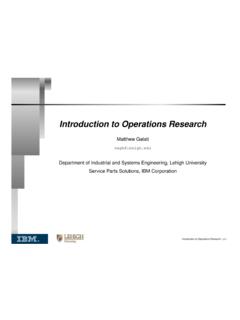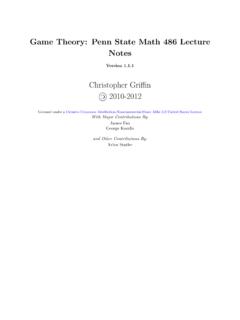Transcription of LECTURE NOTES ON OPERATIONS RESEARCH - …
1 LECTURE NOTES ON OPERATIONS RESEARCH Emad Elbeltagi, , , Professor of Construction Management Structural Engineering Department, Faculty of Engineering, Mansoura University OPERATIONS RESEARCH 2013 Copyright 2009 by the author. All rights reserved. No part of this book may be reproduced or distributed in any form or by any means, or stored in a data base or retrieval system, without the prior written permissions of the author. i PREFACE In the Name of ALLAH the Most Merciful, the Most Compassionate All praise is due to ALLAH and blessings and peace be upon His messenger and servant, Muhammad, and upon his family and companions and whoever follows his guidance until the Day of Resurrection. OPERATIONS RESEARCH is a relatively young field, having emerged during the middle decades of the twentieth century. However, its impact has been quite remarkable.
2 It has become a standard tool for improving the efficiency of business OPERATIONS around the world. This book deals with some tools of a larger field called OPERATIONS RESEARCH . This book is dedicated mainly to undergraduate engineering students, especially Civil Engineering students where most of the applications are presented in the civil engineering field. It provides the reader with the main knowledge to model a given system using linear programming and solving such linear model. It includes five chapters: Chapter 1 provides a general introduction to types of models and the main steps of modeling a system. Chapter 2 introduces the principles of mathematical modeling using linear programming and the graphical solution to solve the model. The simplex method for solving linear programming models is presented in chapter 3.
3 Chapter 4 is dedicated for modeling and solving the transportation and assignment problems. Finally, chapter 5 is dealing with the decision analysis techniques. Many solved examples have been added to enable the students to understand the material presented in this book. Also, each chapter is followed by exercises for training purposes. Finally, May ALLAH accepts this humble work and I hope it will be beneficial to its readers. ii TABLE OF CONTENTS CHAPTER 1: INTRODUCTION The origin of the OPERATIONS RESEARCH science 1 Overview of System Analysis Modeling Approach 1 Types of Models 4 Descriptive versus Prescriptive 4 Deterministic versus Stochastic 5 Statistical Models 5 Rules for Modeling 6 Sample Modeling 6 Sample Model 1 6 Sample Model 2 7 Exercises 8 CHAPTER 2: MODELING WITH LINEAR PROGRAMMING Main Assumptions for Linear Programming 12 Inequalities versus Equations 12 Equations 12 Inequalities 13 Graphical Representation of Inequalities 13 Linear Programming.
4 An Introductory Example 14 Modeling 15 Standard Form of Linear Programming 16 Solving the Model Graphically 17 Terminology of the Model Solution 20 Solving Using Solver Program 22 Second Example: Market Allocations 25 Modeling 25 Solving the Model Graphically 26 Solving Using Solver Program 27 iii Types of Linear Programming Solutions 28 Problems Having Unique Optima 29 Problems Having Alternate Optima 29 Problems Having No Feasible Solution 31 Problems that are Unbounded 31 Limitations of Linear Programming Modeling 32 Linear Programming Models 33 Diet Problem 33 Workforce Planning 35 Financial Portfolio 36 Solved Examples 37 Example 1 37 Example 2 38 Example 3 39 Example 4 40 Example 5 42 Example 6 43 Exercises 44 CHAPTER 3.
5 THE SIMPLEX METHOD Gauss-Jordan Elimination for Solving Linear Equations 51 The Essence of the Simplex Method 54 Setting up the Simplex Method 56 Solution of Linear Programs by the Simplex Method 58 The Simplex Method in Tabular Format 64 Special Cases 66 Tie for Entering Non-Basic Variables 66 Alternate Optimal Solutions 67 Degeneracy 68 Unbounded Optimum (No leaving basic variable) 70 Infeasible Solution 71 iv Equality Constraints 72 The Inequality Constraints 75 Negative Right-hand Sides 75 Minimized Objective 76 Sensitivity Analysis 78 Right-hand Side Sensitivity 79 Objective Function Sensitivity 80 Solved Examples 81 Example 1 81 Example 2 82 Example 3 83 Example 4 84 Exercises 85 CHAPTER 4.
6 THE TRANSPORTATION AND ASSIGNMENT PROBLEMS The Transportation Problem 91 The Transportation Problem Model 94 The Simplex Method for the Transportation Problem 102 Solving the Transportation Problem Using Vogel s Approximation Method 104 The Assignment Problem 114 The Assignment Problem Model 115 Solving the Transportation Problem Using Vogel s Approximation Method 119 Solved Examples 120 Example 1 120 Example 2 122 Example 3 124 Exercises 125 v CHAPTER 5: DECISION ANALYSIS Prototype Example 129 General Representation 130 Decisions under Uncertainty 131 The Max-Min Payoff Criterion 131 The Maximum Likelihood Criterion 132 The Expected Return 132 Decision Trees 136 Sensitivity Analysis 139 Sequential Decisions 140 Conditional Probability 140 Decisions under Conditional Probability 141 Solved Examples 147 Example 1 147 Example 2 148 Example 3 149 Example 4 151 Exercises 152 REFERENCES 156 OPERATIONS RESEARCH 1 Dr.
7 Emad Elbeltagi CHAPTER 1 INTRODUCTION The Origin of the OPERATIONS RESEARCH Science After the industrial revolution and change in organization size and complexity, it becomes more and more difficult to allocate and utilize resources efficiently. However, this science became more advanced since the Second World War as there was an urgent need to allocate the scarce resources to the various military OPERATIONS . Another factor that added greatly to this science is the computer revolution. As it is seen from the name of the course system analysis or analysis of the systems , so it is related to how to conduct and coordinate OPERATIONS within a system or organization. It can be applied to many areas such as, financial planning, health care, military, public services, construction, etc. System analysis operation RESEARCH frequently attempts to find a best solution called the optimum solution - for a given problem.
8 Overview of System Analysis Modeling Approach 1. Define the problem and gather relevant data Mostly, when a practical problem described, it is described in a vague and imprecise way. Therefore, the first order is to develop a well-defined statement of the problem, , determining such things as the appropriate objectives, constraints, inter-relationships, possible alternative courses of action, time limits for making a decision, etc. It is difficult to extract a right answer from the wrong defined problem. OPERATIONS RESEARCH 2 Dr. Emad Elbeltagi It is necessary to seek solutions that are optimal for all variables (the whole organization) rather than suboptimal solutions that are best for only one component.
9 The problem of privatizing the water network of a city generally affects four parties: the owner who desires profit; the employees who desire steady employment; the people who desire low priced and high quality water; the government which desire a continuous services and fair taxes. 2. Formulate a mathematical model to represent the problem After defining the problem, the next phase is to reformulate this problem in a form that is suitable for analysis. Models or idealized representation can be used to express any daily life action such as the motion of a car, chemical reactions, etc. For example, the famous law F = ma, is a sample of mathematical model. So, mathematical model is the system of equations that describe the problem. For example, if there some factors that affect the profitability of an organization (such as number of products, price, production time, etc.)
10 And they need to be determined. These factors are called the decision variables and can be denoted mathematically as x1, x2, .. xn. If the profit is measured in terms of these variables as p = ax1 + bx2 + .. + cxn, this is called the objective function. Any restrictions that may be applied to these variables can be also represented mathematically and called constraints. These constraints can be represented in terms of inequalities or equations such as, x1 0, and dx2 x3 k, etc. The mathematical model, in this case is to choose the values for the decision variables so as to maximize the objective function and respect the given constraints. One of the most used mathematical models is the linear programming models, where the mathematical functions appear in both the objective function and the constraints are all linear functions.
